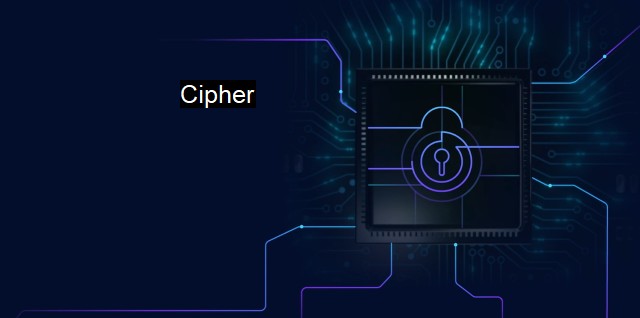What is Cipher?
The Power of Cipher: Protecting Sensitive Data in Cybersecurity and Antivirus Industries
The term "cipher" refers to a type of system used to secure communications and prevent unauthorized access to information. A cipher is an algorithm or a method that can perform both encryption and decryption, the two principal elements in any cryptosystems.Encryption involves converting plaintext, or ordinary readable data, into ciphertext, a seemingly-illogical collection of symbols, digits, or characters. The primary aim is to make the interpreted data comprehensible only to the intended receiver. On the other hand, decryption is the process of transforming the encoded data back into its original, plain text form.
A cipher is mainly composed of a set of well-defined steps, called an algorithm, utilized in carrying out the encryption and decryption processes. The algorithm is applied to the data alongside a key (another input), resulting in an alphanumeric result, either the ciphertext or recovered plaintext. This key can either be public, where everyone knows it, or private, kind of like a password that you must keep to yourself.
Ciphers are considered critical in safeguarding the confidentiality and integrity of digital information as it is transmitted over insecure networks or held in data storage. Ciphers help protect sensitive info from being hacked, stolen, or tampered with, hence ensuring privacy, preventing identity theft, and aiding in the establishment of secure communications channels.
There are two main types of ciphers frequently used in cryptography: substitution ciphers and transposition ciphers. Substitution ciphers replace one character of plaintext with another to make the message unreadable. On the contrary, transposition ciphers rearrange the text characters without changing the original alphabets.
With the advancement of technology, these basic cipher types have evolved into more complex cipher algorithms like DES (Data Encryption Standard), AES (Advanced Encryption Standard), and RSA (Rivest–Shamir–Adleman). DES and AES are common symmetric key encryption techniques, which means both the sender and receiver use the exact key for encrypting and decrypting messages. The RSA algorithm, on the other hand, utilizes an asymmetric encryption technique, one that employs two keys - a private one for decryption and a public one for encryption.
The use of ciphers and their algorithms in cybersecurity has become increasingly vital in our information-dominated societies, where data breach and cyber threats have become regular occurrences. Between individuals, organizations, and even nations, confidential data like credit card information, social security numbers, trade secrets, and state classified information needs to be kept secure. Hence, ciphers come in handy in preventing unauthorized entities from accessing, understanding, or using this information. It’s undeniable that ciphers play an instrumental role in establishing a secure atmosphere for data transmission in the cybersecurity space. as technology advances, so do cyberspace threats and as such, there’s a continuous need to refine, evolve, and create much robust cipher algorithms that can stand the test of sophisticated cyber-attacks.

Cipher FAQs
What is a cipher?
In the context of cybersecurity and antivirus, a cipher is a cryptographic algorithm used to encrypt and decrypt sensitive information. It involves the use of a key to transform plaintext into ciphertext and back again.How are ciphers used in antivirus software?
Antivirus software may use ciphers to protect its own code and to encrypt sensitive information stored on a user's device. Additionally, some viruses and malware use encryption to hide their presence on a device, so antivirus programs may use ciphers to detect and decrypt these hidden threats.What is the difference between a symmetric and asymmetric cipher?
A symmetric cipher uses the same key to encrypt and decrypt data, while an asymmetric cipher uses a public key to encrypt data and a private key to decrypt it. Symmetric ciphers are generally faster and more efficient, but require a secure method to distribute the shared key. Asymmetric ciphers are more secure for key distribution, but are generally slower and more complex.Can ciphers be cracked or decrypted?
In theory, all ciphers can be cracked or decrypted if given enough time and computing power. However, some ciphers are much more secure than others and would require an infeasible amount of time and resources to crack. It is important to regularly update and strengthen encryption methods to stay ahead of potential attackers.| | A | | | B | | | C | | | D | | | E | | | F | | | G | | | H | | | I | | | J | | | K | | | L | | | M | |
| | N | | | O | | | P | | | Q | | | R | | | S | | | T | | | U | | | V | | | W | | | X | | | Y | | | Z | |
| | 1 | | | 2 | | | 3 | | | 4 | | | 7 | | | 8 | | |||||||